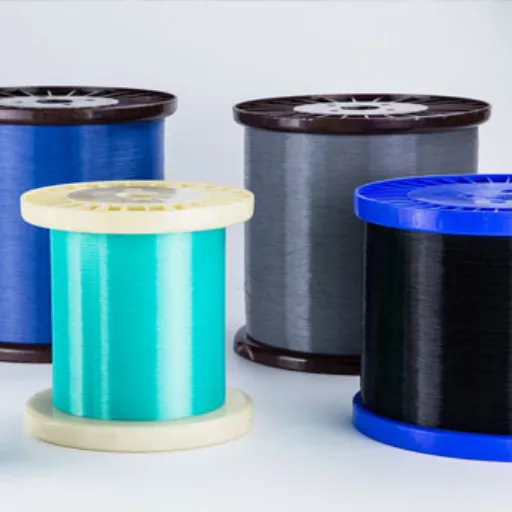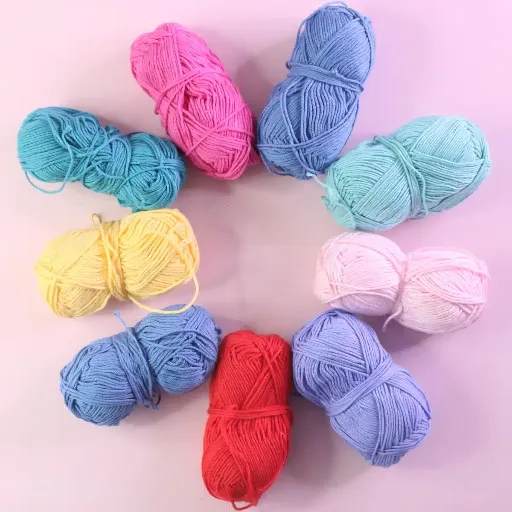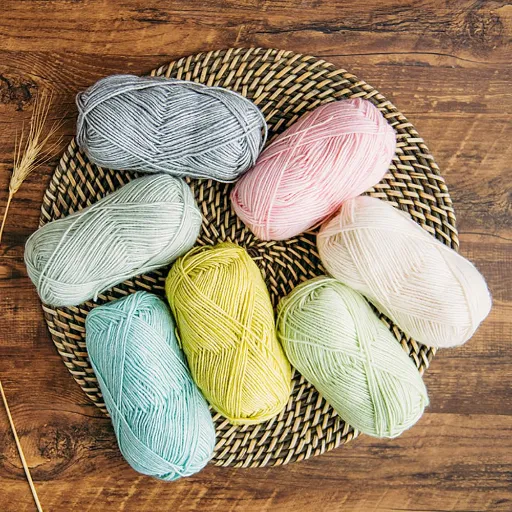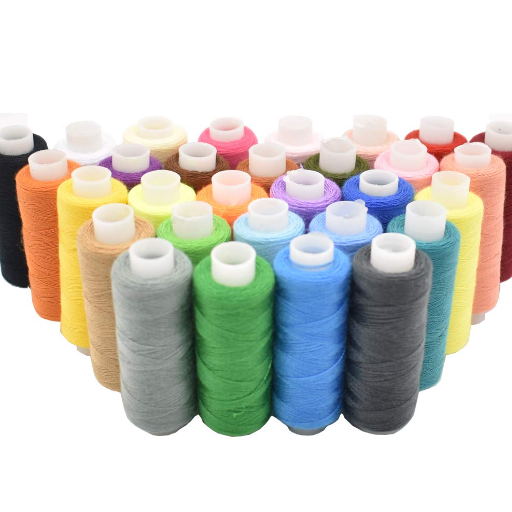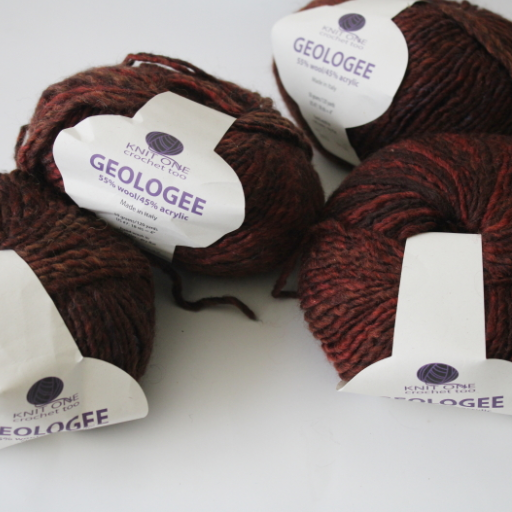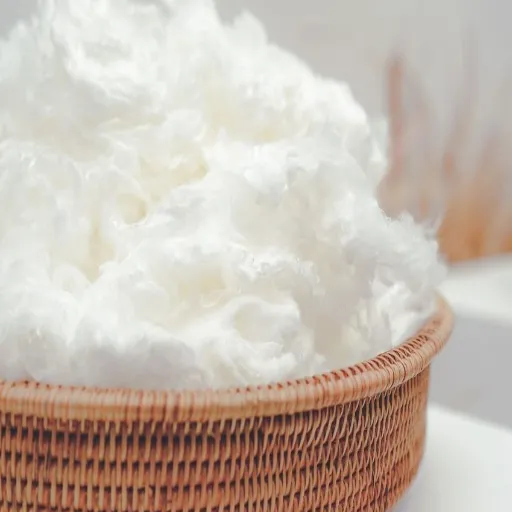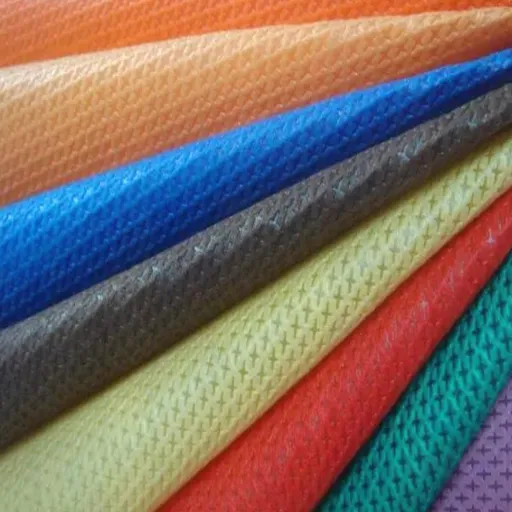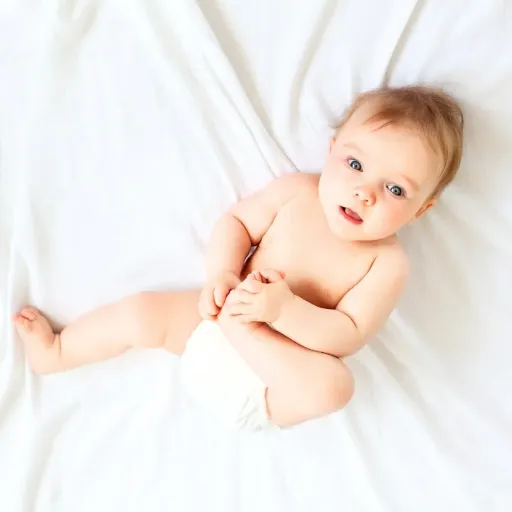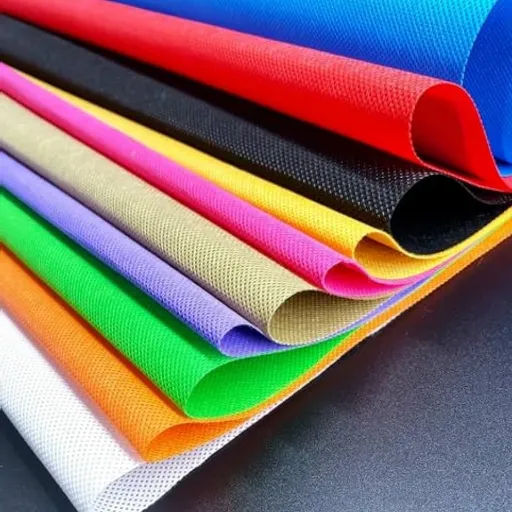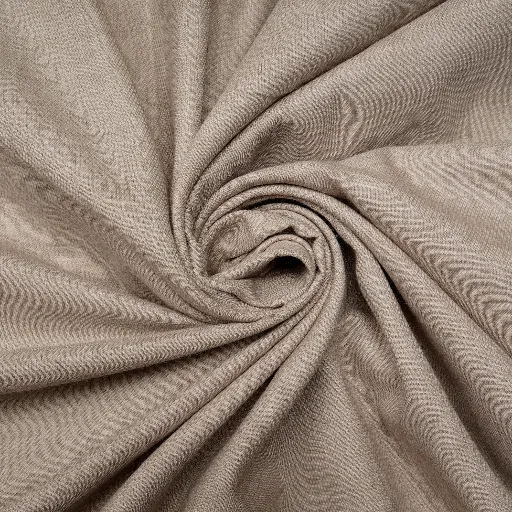One of the many tough choices that parents have to make is the selection of suitable materials for their baby, and polyester is often a point of contention. To be durable and versatile, however, polyester is still not regarded as safe for babies by some, which is why this article will have a thorough look at the matter and present you with the pros and cons, as well as the main issues that need to be thought about, so that you can give your baby the comfort and health you want. Besides learning how polyester affects the skin of babies with allergies, we will be checking its breathability and safety factors and thus, providing you with all the facts you need to make the right choice for your child without any doubts.
Understanding Polyester Fabric

Composition and Manufacturing of Polyester
The synthetic fabric polyester is made by using the products from petroleum. The manufacture of polyester begins with the extraction of crude oil, which is refined into ethylene. Then, the ethylene is combined with other chemicals and through a process called polymerization, a polymer is formed that is referred to as polyethylene terephthalate (PET). PET is the main raw material for the polyester production process.
During the manufacturing process, the spinning of the PET into long, continuous fibers occurs and them the fibers are stretched and woven into fabric. This manufacturing process allows the desirable traits like durability, elasticity, and shrinking resistance to be incorporated into polyester, which makes it the most preferred textile worldwide.
The synthetic nature of polyester offers certain advantages such as being stain-resistant, lightweight, and quick-drying. But, on the other hand, the environment is affected because the non-renewable resources are being used for its production. The composition and the manufacturing process are the factors that will help the consumers to identify the most suitable use of polyester, especially in the case of people with sensitive skin or allergy-prone individuals when deciding on fabrics.
Popularity of Polyester in Baby Clothing and Bedding
The material used in baby clothing and bedding has been switched to polyester mostly because of the new parent’s love of the material’s long-lasting, affordability, and easy to clean features. Polyester is often viewed as a stain-resistant, quick-drying fabric which is a great help where there are spills and frequent washing. With its lightweight and shape retaining quality, polyester becomes one of the best materials for budget-family products as it lasts longer.
But, polyester is not the only option despite it being a common material because of its great qualities. The synthetic nature of polyester might trigger skin irritation in babies that have sensitive skin. Its lower breathability compared to natural fabrics like cotton may sometimes cause discomfort, particularly in hot weather. It is recommended that parents use blended fabrics or do proper layering in order to reduce these issues and at the same time take advantage of the polyester benefits.
In the end, the choice of polyester for baby clothing and bedding is down to the individual needs and preferences. For parents who consider convenience, cost, and durability as their main factors, polyester is still the best option. But, for those who want to maximize comfort feel and minimize allergies, it is advisable to look into alternatives like organic cotton or bamboo fabric. Being aware of the good and bad side of polyester will allow parents to make informed decisions that are specifically designed for their baby’s needs.
Common Baby Products Made from Polyester
Polyester is the most common material in baby products. It is an economical solution, durable and easy to care for. Some examples of common baby products made from polyester include the following:
- Baby Clothing: Polyester is the primary fabric in making baby clothes, including onesies, sleepwear and t-shirts. Usually, these garments are made of a fabric blend that contains polyester for the ease of movement and resistance to creasing. It has been reported recently that about 40% of the baby outfits sold in the market contain polyester due to its price and cleaning benefits.
- Baby Blankets: There are many kinds of baby blankets made from polyester fleece, which is soft and warm. Fleece is also featherlight and dries quickly, which is why it’s a favorite among busy parents. A recent survey states that 60% of baby blankets on the market are composed of polyester fibers.
- Stroller and Car Seat Covers: Polyester is frequently chosen for stroller and car seat padding or even covering because of its durability and stain resistance. By incorporating the water-resistant polyester covers, the stroller and car seat come even more practical and indestructible.
- Stuffed Toys and Plushies: While polyester is and has always been the inside and outside fabric of stuffed toys, it has greatly contributed softness and the ability to keep the shape for an indefinite period. Research indicates that as much as 80% of plush toys could be traced back to polyester.
- Diaper Bags: The majority of diaper bags are made of polyester since it has properties like being tough, light, and breathable. The manufacturers can create trendy and vibrant designs that are also easy to maintain with this fabric, so cleaning is no longer a problem.
Apart from the obvious advantages of polyester, there are recent talks that the material’s environmental impact should be part of the considerations. Parents who want to go green might consider recycled polyester as a sustainable alternative, which is slowly becoming popular among the makers of baby products. This eco-friendly movement paired with functionality continues to lead the baby product industry.
Potential Safety Concerns with Polyester

Skin Irritation and Sensitive Skin Issues
Polyester, being any product for babies, may sometimes prove otherwise for infant skin-sensitivities. It causes skin irritation to some extent, especially when it is not properly breathable or is chemically treated. Certain babies with existing conditions might easily react to such irritations; for instance, eczema.
To keep any possible irritation at bay, parents should seek out polyester blend baby products made from soft, breathable fabrics. Any items that say they are hypoallergenic or made especially for sensitive skin might lessen the chance of an adverse reaction. On top of that, washing the polyester products before use using a mild detergent that is safe for both babies and people could remove any lingering chemicals or irritants.
An irritation is developing? Worse polymer products must be discontinued so that a pediatrician can be consulted for advice. Alternatives composed of natural fibers, such as organic cotton, may comprise safer options in such cases. Monitoring the baby for any redness or signs of discomfort is essential in ensuring his or her comfort.
Breathability Challenges of Polyester Fabric
A synthesis of this durable yet cheap material is the Polyester. However, almost the immediate drawback turns out to be inferior breathability. Unlike natural fabrics such as cotton, polyester cannot wick moisture away efficiently, thus trapping heat and sweat on the skin. In hotter climes or during strenuous physical work, heat and sweat accumulation may cause great discomfort.
Lack of breathability comes about in polyester because the fibers are not very porous compared to natural ones. Being that these synthetic fibers are woven or knitted so tightly, they allow hardly any airflow. Without ventilation, polyester clothing can prove a threat by making people feel hot, working on them to perspire inordinate amounts, and could end up irritating their skin. This is why it is not preferable to use polyester in garments intended for wear under hot or humid conditions wherein breathability ranks high.
Choosing lightweight, moisture-wicking polyester blends or clothing with mesh-paneling or ventilation features for the purpose of facing such challenges should be on the priority list. Otherwise, going with breathable natural fabrics like cotton or linen may work for you. Being alert to fabric and design can really help in keeping the discomfort at bay because of the lack of breathability in polyesters.
Toxic Chemicals and Treatments in Making Polyester
The manufacturing of polyester includes hazardous chemicals and treatments that can place at risk the environment and human health, with the former regarded as one of the major issues. In this aspect, the use of petrochemicals in manufacture is a prime concern. Polyester is a product of petrochemical origin, and the extraction and refinement of such a raw material increase the greenhouse gas emissions in the atmosphere and encourage environmental degradation. These processes can sometimes generate toxic byproducts that are released into the air or water.
Similarly, during the dyeing and finishing stages of production, heavy metals and toxic dyes are frequently requested for use on polyesters. If these chemicals do not receive proper wastewater treatment, they will continue to pollute the ecosystems surrounding their disposal sites, causing harm to the aquatic life. On the other hand, some of these treatments can emit VOCs, such as those formaldehyde-based ones used for wrinkle resistance, which are a hazard to human health when inhaled.
These risks have an adverse effect on consumers as well. Polyester fabrics treated with chemicals may cause skin irritation and allergic reactions in sensitive customers; otherwise, depending upon the chemicals, it may cause respiratory issues. Plants and processes alone for completing toxic finishes compounded for secondary toxicity are the hazards for working, so there is a need for a stricter working environment and safer practices in polyester processing. Sustainable alternatives and technologies aim to reduce these hazards, but awareness remains critical to decide.
Benefits and Drawbacks of Polyester for Babies
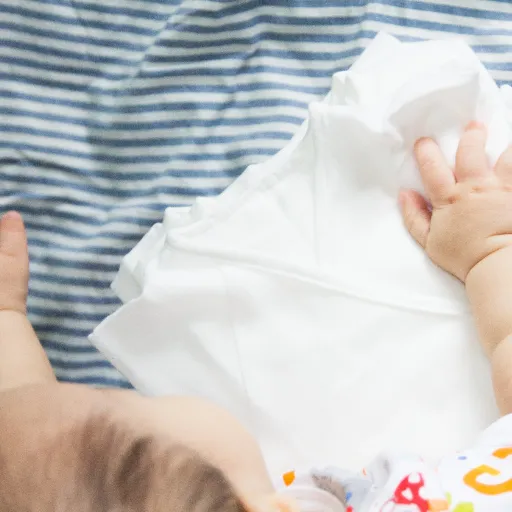
Durability and Cost-Effectiveness of Polyester
Polyester is immutablely durable, making it perfectly suited to synthesize baby clothes and accessories. The synthetic fibers are resistant to stretching, shrinking, and wrinkling, therefore if worn and washed frequently, it ought to stand the test of time. This durable ability is especially important for baby products, which must tolerate spills, stains, washes, and form retention to serve their purpose. Moreover, the resistance to fading enables polyester products to maintain their graceful looks through the years.
Being a fully synthetic fiber, polyester is almost always cheaper and cost-effective compared to natural fiber-based textiles such as cotton. Production-wise, polyester is cheaper and less more labor-intensive. This makes it attractive to budget-conscious parents buying in bulk for their child needs, not compromising on quality or function. Also, polyester being durable in nature, eliminates the need for frequent replacements, making it cost-efficient over a long period.
A few cons also outweigh. Being a synthetic material, polyester for the most part misses out on the breathability and softness, say, that cotton possesses. Babies are soft-skinned, and some can feel discomfort or irritation due to polyester fabrics, especially in warmer situations. It is heat-retaining and might be unwelcome in some situations. Its affordability and durability are obvious bumps in the scale; however, any parent must weigh these benefits with their own pros and cons on how comfortable or suitable they will feel answering to their baby’s delicate skin. Some of those problems may be compensated with sustainable or blended polyester.
Okay, Cleaning Ease vs. Synthetic Fiber Concerns
Polyester materials, staying famously loved because of their dirt-phobic nature and general ease of cleaning, are resistant to staining and can usually be simply thrown into the washing machine with common detergents. This composure may pose a real problem for busy working parents who make convenience a priority in the maintenance of their baby’s clothing. From a use standpoint, it slashes drying time, thereby cutting down on the time needed for laundry.
But one cannot turn a blind eye to the concerns that come with synthetic fibers. Polyester is less breathable than natural fibers, causing discomfort and sometimes overheating in warm environments or if worn for long hours. Moreover, the synthetic fabric discharges microplastic in the water during washing, leading to pollution in due course. These disadvantages somehow put into question the very idea of the long-term suitability of polyester for both baby and earth.
In a bid to best balance ease of cleaning against the dye and fabric issues, parents might consider such as polyester blends and other options in sustainable fabrics. Blended options tend to retain the cleaner advantages of poly while giving in a little to the contrary of the more breathable fiber for the comfort of being airier. With these alternatives, some issues related to synthetic substances may be solved, steadily leading to a more sustainable, baby-friendly solution.
Heat Retention and Comfort for Babies
Comfort and warmth for babies largely to do with their clothing and bedding materials. Unlike adults, babies cannot really regulate the body’s internal temperature. Thus, one has to opt for materials that keep them warm while allowing air to pass through. Cotton and other natural fibers would be most ideal simply because they are soft to the touch, gentle for a baby’s skin, and breathable to prevent overheating. In addition, a wool blend provides insulation from cold weather while being sufficiently comfortable.
Fit and layering of a baby’s clothes is another factor that goes into this. Good airy fit may loom well increased insulation, but surely they must never become a suffocation risk or just an inconvenience to the baby. Layering is usually useful because any caregiver will be able to add or remove layers depending on the baby’s needs or the prevailing environment. In contrast, keep from overwrap, for the help of this could cause overheating, which in turn adds the chance of sudden infant death syndrome (SIDS), mostly when done during sleep.
The room temperature or use of something such as a swaddle or a sleep sack comes into play in this final instance. The temperature should be adequately maintained between 68°F and 72°F (20°C and 22°C), so that an infant is comfortable without getting hot. Crosley swaddles, being even lighter and more breathable, could give babies a warm hug without the risks of overheating. Therefore, focusing equally on the fabric, the layers, and the environment would give the caregivers the best solution to create heat retention and comfort which is conducive to the babies.
Expert Opinions on Polyester Safety
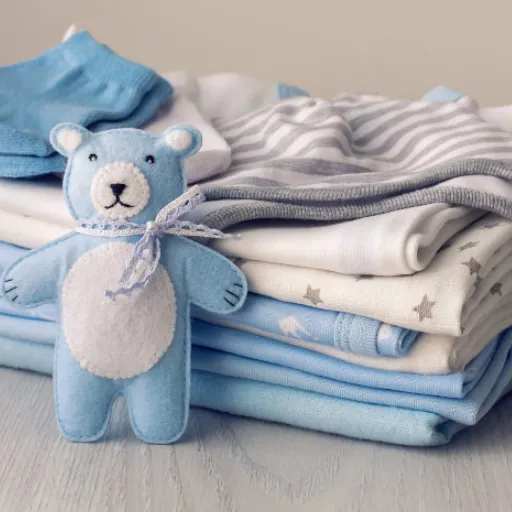
Insights from Pediatricians and Dermatologists
According to pediatricians, safety and comfort are the two main criteria for materials being contacted by the baby: for instance, swaddles or clothing. Polyester is questioned very often by those who are concerned about its potential to irritate and presumably less breathability of this synthetic fabric. Experts concur that, although polyester generally poses no danger, it is less and less so in cases where the baby has a more sensitive skin condition or is already ailing from some skin condition, e.g., eczema. Natural fibers should always be preferred due to their softness, breathability, and hypoallergenic features.
Some dermatologists point out that where the darker side to polyester exists is in its lack of moisture-wicking unlike most natural fibers; thus, it leads to overheating or discomfort for an infant in warm places. The accumulated heat and sweat may cuddle the formation of rash or irritation, especially where the fabric is tightly fitted against the skin. So parents should certainly go for lightweight and loosely woven fabrics that allow enough air to pass through for temperature regulation, particularly in warmer climates and for prolonged wear.
Pediatricians and dermatologists emphasize taking into consideration a baby child’s special needs: climate, skin sensitivity, and their comfort. They suggested watching the baby’s reaction with each material and changing if necessary. Parents who decide on fabrics should perform daily checks for signs of irritation, such as redness or discomfort, to know what is best for their children’s health and well-being.
Toxicological Findings Related to Polyester Use
Polyester, a synthetic fiber, finds applications in clothing and miscellaneous products, but toxicological issues come into play. Dyeing is just one step of the finishing process that places chemicals in and upon the fiber; flame retardants and water repellants are others. In poorly ventilated areas, these treatments can let off VOCs and other harmful chemicals. Exposure to these chemicals may cause skin irritation, allergic reaction, or respiratory problems in sensitive persons, including infants and young children.
Another issue with polyester lies in its temperature regulation and moisture absorption. Polyester doesn’t breathe well; it is in contrast with natural fibers like cotton that allow the free passage of air through them. It locks heat and sweat close to a one’s skin. This sets an ambiance for irritations or fungal infections, especially for individuals that have sensitive skin or pre-existence conditions. Parents should exercise caution in the choice of polyester outfits for babies since they are more prone to such effects.
In addition, research shows potential environmental and health risks involved in the polyester life cycle. The microplastics that are shed during washing can enter the waterways, contributing to ecological harm and perhaps harming human health when they enter the food chain. While this larger picture is not immediately relevant to the kind of use by the end-user, it poses the question of weighing convenience against toxicity in synthetic materials. Considering an alternative that uses less chemical treatment or combines some natural fibers would be relatively safer and sustainable.
Recommendations for Parents Choosing Baby Products
Above all else, make sure the safety of the product is a priority. Avoid any products that contain chemicals such as phthalates, BPA, and formaldehyde since they may be harmful to the child. Labels stating “non-toxic” or “organic” may be helpful, and always double-check that the product conforms to safety standards of authorities concerned. Strong chemical smells should be avoided, as such odors might hint at toxic substances inside.
Try to buy baby products that are made from natural or less-processed materials. For instance, organic cotton or bamboo can be considered for clothes or bedding since these fibers are soft on the infant’s delicate skin and are generally treated with fewer aggressive chemicals. For bottle-feeding, glass or stainless steel bottles may be a more conscientious option compared to plastic ones-the fewer chances of causing exposure to something questionable!
Lastly, consider the sustainability and functionality of the products that you choose. Items that are reusable, biodegradable, or made from sustainable materials will reduce environmental impact and will also provide value over the long term. Do not buy in large quantities but rather to buy quality, and research or seek advice from trusted sources to make well-informed decisions suitable for your baby.
Practical Tips for Parents Considering Polyester Products
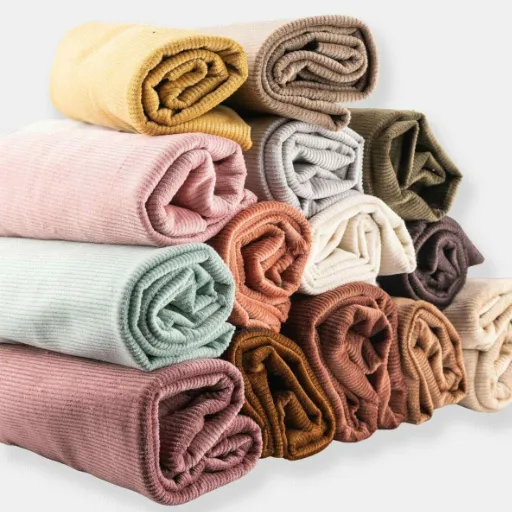
How to Check for Certifications and Safety Standards
I want my baby to be cushioned by polyester material that meets the highest safety parameter, so I focus on the few steps and guidelines to check for certifications and safety standards:
- Global safety certification: While checking, keep improvising certifications like OEKO-TEX Standard 100, which certifies that textiles are tested for harmful substances and are safe for baby products. Another certificate is Global Organic Textile Standard (GOTS), which considers both environmental and social criteria. These products are tested for their safety and are set to a very high international level.
- Review Flammability Standards: It is much common for polyester fabrics to be treated with flame retardants simply so that they may be made to conform to various safety laws. Confirm, however, that these treatments are not toxic and that they comply with national safety regulations such as the U. S. Consumer Product Safety Commission (CPSC) flammability standards. Some flame retardants could have harmful chemistries, so be sure that the manufacturer’s paperwork adequately declares the materials.
- BPA-Free and Non-Toxic Finish and Coatings: Sometimes these additives might be applied to polyester baby products such as bibs or bottles. Verify that the additives meet regulations, such as the Food and Drug Administration (FDA) on non-toxicity, that relates especially to anything that comes in contact with food or a baby’s mouth.
- Products That Are Third-Party Verified: A third-party certification from trusted organizations such as GREENGUARD indicates that the product complies with limits of chemical emissions. Such labels guarantee that the product is safe to use indoors and has reduced allergen and chemical exposure risks.
- Research Manufacturer Compliance: Go direct to the manufacturer’s web page and check its commitment to safety standards. Check also their compliance with ASTM International standards or any regional standards such as the European Union’s REACH regulation, which tackles chemical safety of products.
Choosing Hypoallergenic Polyester Options
Polyester can be safe for babies if used and chosen correctly. This is the most commonly used fabric in baby clothing, beddings, and accessories, because it is durable, cheap, and easy to clean. However, some polyester products are not safe as they contain harmful chemicals and/or may not have been manufactured in accordance with safety standards.
When selecting polyester for babies, consider only those that claim hypoallergenic and are certified free of toxic substances. Such certifications include OEKO-TEX Standard 100 and REACH regulations, which certify that a fabric has been tested for safety and should not harm sensitive skin with irritation symptoms. Always opt for soft blends of polyester with a light feel so as not to induce discomfort or overheating.
Some items can become irritants if they are poorly made or if proper washing methods are not correctly followed. Care instructions and quality for the polyester should be checked to further ensure safety. Washing properly and maintenance procedures help in minimizing possible irritants such as residues and allergens. Polyester can be good for babies, but parents need to be on the lookout for any signs of skin irritation or discomfort and, if such signs appear, consider opting for natural fibers.
Alternatives to Polyester for Sensitive Babies
Natural fibers are best for babies with sensitive skin. Cotton- especially organic cotton, is said to be excellent because of its soft and breathable nature, further hypoallergenic. It facilitates air circulation so that babies are less likely to sweat or feel irritated. It is easy to clean, too, and durable to ensure comfort and convenience.
Other options are bamboo fabrics that have the natural feel of softness and moisture-wicking function. Bamboo, besides being hypoallergenic, is biodegradable, which makes it safe for the environment. Being soft, it can go a long way in giving comfort to sensitive baby skin without any irritation.
Wool, particularly merino wool, is yet another fine choice. It offers a regulating effect on temperature; thus, it keeps the baby warm in colder months and cool down in hot summer days. Environmentally conscious options include sourcing such materials as wool through sustainable means. Natural fiber alternatives focus on comforting and safer options for a baby while lessening irritation speed caused by synthetic materials such as polyester.
Frequently Asked Questions (FAQ)
Q: Is polyester safe for babies?
A: Using polyester for babies, in their clothing and blankets, is mostly regarded as safe. Nonetheless, it is important that the polyester is indeed free from any harmful chemicals often linked to the manufacture of synthetic fabrics.
Q: What hazards does polyester impose on babies?
A: In general, degradation of comfort to the child and chemical sensitivity are the hazards that polyester poses. Chemicals in the making of synthetic fabric, like polyester, are of concern. Being cautious of choosing any polyester items labeled as safe and gentle for infants is of the utmost importance.
Q: Can babies wear polyester clothing?
A: Yes, polyester clothes are worn by many babies. But parents must choose their polyesters carefully, ensuring that they are soft and comfortable. The less the fabric irritates the skin, or causes allergic reactions, technically the better it is for polyester to be worn.
Q: How does polyester fare compared to natural fabrics such as organic cotton?
A: Polyester is probably the most common synthetic material used for baby stuff, but natural fabrics, especially organic cotton, are considered more breathable and soft. Thus, organic fabrics may be perceived by parents as safer for baby clothes.
Q: Do polyester baby products offer any good sides?
A: Polyester is durable and easy to maintain. It is a practical man-made fiber for many baby products. It is usually found in items for heavy washing, such as children’s wear, without them losing shape or color.
Q: Is polyester completely bad for babies?
A: Completely avoiding polyester is not necessary, but parents must be aware of what types of polyester fabric are available. Using polyester from recycled fabrics might be a good alternative, with safer and greener considerations.
Q: What should I be looking for while buying polyester items for my baby?
A: When shopping for polyester apparel for babies, it is recommended to use one that has been labeled safe for babies, free from harmful chemicals, and from recycled plastic. Comfort or breathability should also be considered when selecting the fabrics.
Q: Are there any polyester alternatives for baby clothes?
A: Yes, polyester alternatives include natural fabrics such as organic cotton and bamboo. They generally feel softer on the skin, allow better air circulation, and are believed to be safer to wear by babies.
Q: How can I make sure that the polyester I am choosing is safe for my baby?
A: To guarantee safety for baby polyester, it is always best to choose products from reputable brands that put safety first, check for certifications in the absence of harmful chemicals, and ensure that the polyester is made for infant use.
References
- The Roundup: Is Polyester Safe for Babies? Facts All Parents Should Know – Discusses potential skin irritation, breathability issues, and microplastic concerns.
- Cuddle Sprouts Blog: Is Polyester Safe for Babies? – Highlights polyester’s safety and its impact on sensitive skin.
- Star Sweepers: Avoiding Harmful Chemicals. Is Polyester Safe for Babies? – Explores chemical processing and breathability concerns.
- University Hospitals Blog: Do Your Child’s Clothing, Bedding and Mattress Have Toxic Chemicals? – Discusses the presence of harmful chemicals in synthetic fabrics like polyester.
- Reddit Discussion: Polyester, anyone? – Offers community opinions and experiences regarding polyester use for children.








